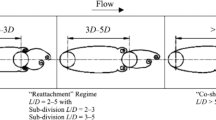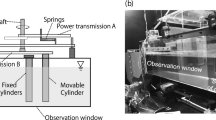Abstract
The work investigates flow-induced response of a circular cylinder interacting with another smaller diameter cylinder placed upstream. The upstream cylinder diameter d was varied from 0.24 to 1.00 times the diameter D of the downstream cylinder, which was cantilever-supported. Experimental observation was made at a spacing ratio, L/d, of 1–2, where L is the center of the upstream cylinder to the forward stagnation point of the downstream. A violent vibration of the cylinder occurred at d/D = 0.24–0.8 for L/d = 1 or d/D = 0.24–0.6 for L/d = 2, but not at d/D = 1. The violent vibration occurs at a reduced velocity U r = 13–22.5, depending on d/D and L/d, and increases rapidly, along with the fluctuating lift, for a higher U r . At a small d/D, the upstream cylinder wake narrows, hence the high-speed slice of the shear layer could flow alternately along the two different sides of this cylinder, thus exciting the downstream cylinder.
Access provided by Autonomous University of Puebla. Download conference paper PDF
Similar content being viewed by others
Keywords
1 Introduction
Flow-induced vibrations of two interacting cylinders subjected to a cross flow have been the subject of intensive research because of relevance to the engineering structural design and acoustic emission problems. A detailed survey of the literature relating to flow-induced response of two cylinders suggests that previous investigations mostly were performed for two cylinders of an identical diameter (e.g., Bokaian and Geoola 1984). The literature mainly clarified L/d range where vortex-resonance or galloping persists (see Fig. 1 for definition of symbols). Rahmanian et al. (2012) performed a numerical simulation on vortex-induced vibrations of two cylinders of d/D = 0.1 where the cylinders were mechanically coupled, behaving as one combined cylinder. The interaction between the coupled cylinders led to a very irregular vibration of the bundle both in-line and cross-flow directions. There does not seem to have a systematic study on flow-induced response of the downstream cylinder when the upstream cylinder size (diameter) is changed. Hence a number of questions are still unanswered. First, what is the effect of the upstream cylinder diameter on the flow-induced response of the downstream cylinder? Second, how much force on the base structure is induced when a structure experiences vortex-excitation (VE) or galloping? Finally, what is the physics behind the generation of galloping for tandem cylinders, though galloping in general is not generated on an isolated circular cylinder (axis-symmetric body)?
The objectives of the present study are to experimentally investigate flow-induced response of a cantilever circular cylinder in the presence of an upstream cylinder of different diameters. The flow-induced responses A x and A y in the x- and y-direction (where A stands for amplitude of vibration at the free end of the cylinder) and fluctuating (rms) drag (C Drms) and lift (C Lrms) forces on the cylinder base are systematically measured for reduced velocity U r = 0.8–32. Furthermore, wake and vortex-shedding frequency f v behind the downstream cylinder and in the gap between the cylinders are examined.
2 Experimental Details
Experiments were conducted in a low-speed, close-circuit wind tunnel with a test section of 600 × 600 mm. The upstream cylinder of diameter d was solid and fixed-mounted at both ends (Fig. 1). The downstream cylinder of outer diameter D = 25 mm was hollow, 700 mm in length, and cantilever-mounted on an external rigid support detached from the wind-tunnel wall. d was 25, 20, 15, 10, and 6 mm, respectively. Free-stream velocity U ∞ was varied from 0.5 to 20 m/s, corresponding to variation of U r from 0.8 to 32 and Reynolds numbers (Re) from 825 to 3.3 × 104 based on D and U ∞ . Two hotwires were used to measure the frequencies of vortex shedding from the cylinders. A three-component strain-gauge load cell (KYOWA Model LSM-B-500NSA1) was installed at the base of the downstream cylinder to measure the force. Free-end vibration displacement of the cylinder was measured by using a standard laser vibrometer. To visualize the flow, smoke was introduced into the flow from the midspan of the upstream cylinder through six 0.75 mm-diameter pinholes, three at an azimuthal angle θ = +30° with a 2 mm spanwise spacing between the holes and the other three at θ = −30° with the same spanwise spacing, where θ is measured from the front stagnation point. A Dantec PIV CCD camera was used to capture the flow images.
3 Results and Discussion
3.1 Flow-Induced Response
The cylinder system had a mass-damping (m*ζ) value of 4.33 with the first mode natural frequency f n1 = 24.9, where m* and ζ are the mass and damping ratios, respectively. Figure 2 illustrates vibration amplitude A y /D and A x /D at L/d = 1 for d/D = 0 (single cylinder), 0.24, 0.4, 0.6, 0.8, and 1.0. The horizontal axis U r is based on f n1 . Violent vibration is unveiled at d/D = 0.24, 0.4, 0.6, and 0.8 for U r > 13, 13, 19.5, and 22.5, respectively, in addition to a visible VE at U r = 4.75 for d/D = 0.24 and 0.4. For other d/D, a very tiny hump generated at the same U r (see the insert of Fig. 2) is the sign of VE, A y /D at the hump is less than 0.003 corresponding to 0.075 mm vibration amplitude; hence, it can be said that VE is practically suppressed. Note that VE speed U r0 calculated from the Strouhal number of the cylinder fixed at both ends was 5, 5.3, 5.12, 5.1, 4.74, and 4.58 for d/D = 0, 0.24, 0.4, 0.6, 0.8, and 1.0, respectively. Vibration due to VE started at U r = 4.4 and reached to a maximum at U r = 4.75. On the other hand, the galloping occurred for U r > 11.3. For the galloping generated cases d/D = 0.24–0.8, the starting U r of vibration generation is lower for lower d/D, implying that a decreasing d/D anyhow causes a higher instability of flow and/or an increase of negative damping on the cylinder. At L/d = 2, vibration was generated for d/D = 0.24–0.6 (not shown).
3.2 Forces on the Cylinder
Figure 3 shows variations of C Drms and C Lrms with U r at L/d = 1. C Drms and C Lrms are highly sensitive to U r for d/D = 0.24–0.8, but less for d/D = 0 and 1.0. For d/D = 0, they are more or less constant at about 0.11 and 0.23, respectively for U r < 25. These values are however the same as those measured for both ends fixed. They however increase slightly for U r > 25. This is due to a synchronization of the vortex-shedding frequency f v with the second-mode natural frequency f n2 of the cylinder. Note that the value of U r corresponding to f v synchronization at f n2 is 32, estimated from Strouhal number. The most important feature in the figure is that C Lrms for d/D = 0.24, 0.4, 0.6, and 0.8 launches to intensify itself at U r = 13, 13, 19.5, and 22.5, respectively, where vibration starts to occur. At U r = 25.5, where A y /D is about 0.23, 0.26, 0.205 and 0.192 for d/D = 0.24, 0.4, 0.6, and 0.8, respectively, C Lrms intensified by 48, 78, 57, and 45 times, respectively, compared with that for d/D = 0 or for a fixed cylinder. C Drms is quite low even in the high-amplitude vibration regime, confirming vibration generated dominantly in the cross-flow direction. Similar observation is made at L/d = 2 (not shown).
3.3 Fluid–Structure Interaction and Vibration Generation
For fixed cylinders (Fig. 4a), the two shear layers emanating from the upstream cylinder reattach steadily on the downstream cylinder. Indeed, the vibration mainly results from the switching instability of the shear layers emanating from the upstream cylinder. The switching instability is generated from whether the high-velocity slice of a shear layer passes on the same side or opposite side of the downstream cylinder (Fig. 4b). The high-velocity slice generates highly negative pressure on the surface over which it goes. When the cylinder is moving upward from its centerline (Fig. 4c, d), the high-velocity slice of the upper shear layer goes on the upper side and causes an upward lift force to pull the cylinder upward. On the other hand, when the cylinder is moving down (Fig. 4e, f), toward the centerline, the high-velocity slice of the same shear layer sweeps the lower side; hence a downward lift force is generated to pull the cylinder toward the centerline. Similarly, the next half cycle is associated with the lower shear layer. Previous sections proved that a smaller d/D is more prone to generate vibration. Why? A smaller d/D is accompanied by a narrow wake between the cylinders, hence the shear layers are more prone to switch and results in the vibration.
4 Conclusions
-
1.
The downstream cylinder experiences violent vibration when the upstream cylinder diameter is d/D = 0.24–0.8 for L/d = 1 and d/D = 0.24–0.6 for L/d = 2.
-
2.
The vibration causes an intensification of C Lrms. Compared with that for d/D = 0 or for a fixed cylinder, C Lrms for d/D = 0.24, 0.4, 0.6, and 0.8 intensified by 48, 78, 57, and 45 times, respectively at U r = 25.5 where A y /D is about 0.23, 0.26, 0.205, and 0.192, respectively.
-
3.
Decreasing d/D is prone to generate vibration. At a small d/D, the upstream cylinder wake narrows, and the shear layer reattachment position on the downstream cylinder approaches the front stagnation point, and hence the high-speed slice of the shear layer could flow alternately along the two different sides of this cylinder, thus exciting the downstream cylinder.
References
Bokaian A, Geoola F (1984) Wake-induced galloping of two interfering circular cylinders. J Fluid Mech 146:383–415
Rahmanian M, Zhao M, Cheng L, Zhou T (2012) Two-degree-of-freedom vortex-induced vibration of two mechanically coupled cylinders of different diameters in steady current. J Fluids Struct 35:133–159
Acknowledgements
YZ wishes to acknowledge support given to him from Natural Science Foundation of China through grants 11172085 and 50930007. Alam wishes to acknowledge Shenzhen Govt support through grant JCYJ20120613145300404.
Author information
Authors and Affiliations
Corresponding author
Editor information
Editors and Affiliations
Rights and permissions
Copyright information
© 2014 Springer-Verlag Berlin Heidelberg
About this paper
Cite this paper
Alam, M.M., Zhou, Y. (2014). Flow-Induced Vibrations of a Circular Cylinder Interacting with Another of Different Diameter. In: Zhou, Y., Liu, Y., Huang, L., Hodges, D. (eds) Fluid-Structure-Sound Interactions and Control. Lecture Notes in Mechanical Engineering. Springer, Berlin, Heidelberg. https://doi.org/10.1007/978-3-642-40371-2_55
Download citation
DOI: https://doi.org/10.1007/978-3-642-40371-2_55
Published:
Publisher Name: Springer, Berlin, Heidelberg
Print ISBN: 978-3-642-40370-5
Online ISBN: 978-3-642-40371-2
eBook Packages: EngineeringEngineering (R0)








